Editor's Note: This review was updated on November 11, 2021, with final thoughts on New World's endgame content.
It's not every day a new, big-budget MMORPG arrives, much less one developed by Amazon. In recent years, the MMO genre has largely been forgotten, with only new expansions for the biggest names in the genre to satisfy fans. But back in the mid-to-late 2000s, new MMOs felt like they were a dime a dozen, with game publishers all looking for a piece of the massive pie that Blizzard had carved out for itself starting with vanilla World of Warcraft in 2004.
It's fitting then that New World in many ways feels like it originated from that particular period of gaming history. Old-school in many of its sensibilities, New World is a social, player-versus-player-focused MMO the likes of which largely hasn't been seen since 2001's Dark Age of Camelot. Based on the more than 140 hours I've played so far, there is definitely some enjoyment to be had, particularly for those interested in PvP. Unfortunately, New World is also held back by a largely boring leveling experience and a few particularly annoying design choices that may turn off even the most dedicated MMORPG fans.
The setup of New World is simple: After creating a character, you wash up on the shores of a mysterious uncharted island somewhere in the Atlantic ocean called Aeternum. Turns out, people have been washing up there for thousands of years and are unable to return to their homelands thanks to a mysterious storm surrounding the island. People don't really die, or even age, in Aeternum, but that doesn't mean life is easy. Those who have lived on the island for ages run the risk of becoming soulless husks known as the Lost, or even worse, are in jeopardy of being brainwashed by an ancient evil spreading across the land known as the Corruption. It's up to players to rebuild and lead an order of guardians known as the Soulwardens if Aeternum is to stand a chance against the encroaching darkness. As you embark on your adventure to level 60, you'll gather crafting materials, fight monsters, equip new weapons and armor, complete quests, and level up your character.
While the game is technically set in the 16th century, and much of the game's armor and weapons invoke the "Age of Exploration," Aeternum is a fantasy world filled with ghouls, ghosts, plant monsters, and magic. If the island did have original inhabitants (as is implied by many of the game's massive and mysterious ruins) they are long since gone and nobody knows what happened to them. There are no other humans to fight and kill, aside from rival players (should you choose to engage in PvP), and even then, everyone miraculously comes back to life, both for gameplay purposes and thanks to the island's magical properties. Everyone in Aeternum is a stranger in a strange land.
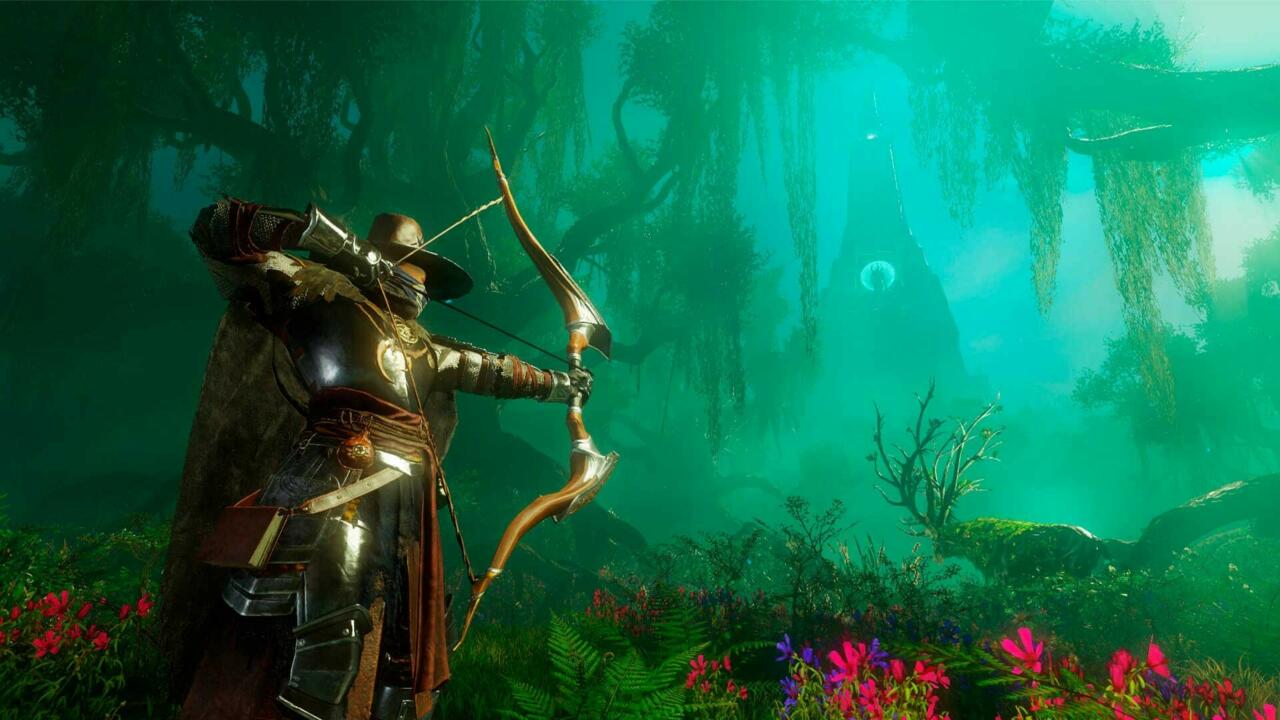
Regardless, story and lore is not much of a priority for New World, with most of the game's narrative coming from optional journal entries that can be discovered throughout the world. What New World is much more focused on, and what players are likely to be playing the game for, is Aeternum's PvP faction war. Early on, you are able to join one of three factions: the Covenant, the Marauders, or the Syndicate. Each faction has a corresponding reputation attached, and completing tasks for your faction rewards tokens and rank which can be used to acquire more powerful weapons or rare crafting materials.
To call Wars both thrilling and chaotic would be an understatement. I've fought in a few in my time with the game so far, mostly on the defending side, and they have yet to get old.
Factions are the lens through which nearly every aspect of the game's world is viewed. This is quite literal, as the in-game map of Aeternum is color-coated according to which faction owns which regions of the world. It's scary how quickly you can become attached to your faction of choice, and whenever the Covenant claimed a new territory or defended one of its own, I couldn't help but take pride in my faction's accomplishments, regardless if I actually participated or not.
Owning territory is the name of the game when it comes to PvP, but it has ramifications for PvE players as well. The different player-run companies within each faction essentially run New World, setting territory tax rates, building defenses, and upgrading crafting stations. Players who are a member of a territory's dominant faction receive various perks, ranging from cheaper homes to reduced fast travel costs.

To claim an enemy territory, the invading faction must first declare War. That's done by having players of the contesting faction complete open-world PvP missions in that particular territory. Do this enough times and the invading faction's "influence" in the territory will grow, until the point where a "War," a 50v50 PvP battle, can be declared. I've been on both sides of the tug-of-war like battles to build up (or bring down) influence in a territory, and the stakes always feel high. Killing players on PvP missions will cause them to fail the mission, thus denying them the chance to build up influence. It soon becomes a quest to take out as many hostile players as possible, with each kill feeling like an important victory in the name of your faction.
Wars are winner-takes-all affairs. Defenders must defend a fort by preventing the enemy from controlling various capture points. Attackers must capture each point before time runs out, with the ability to call in siege engines to aid them in their struggle. Whichever faction wins the War gains control of the territory.
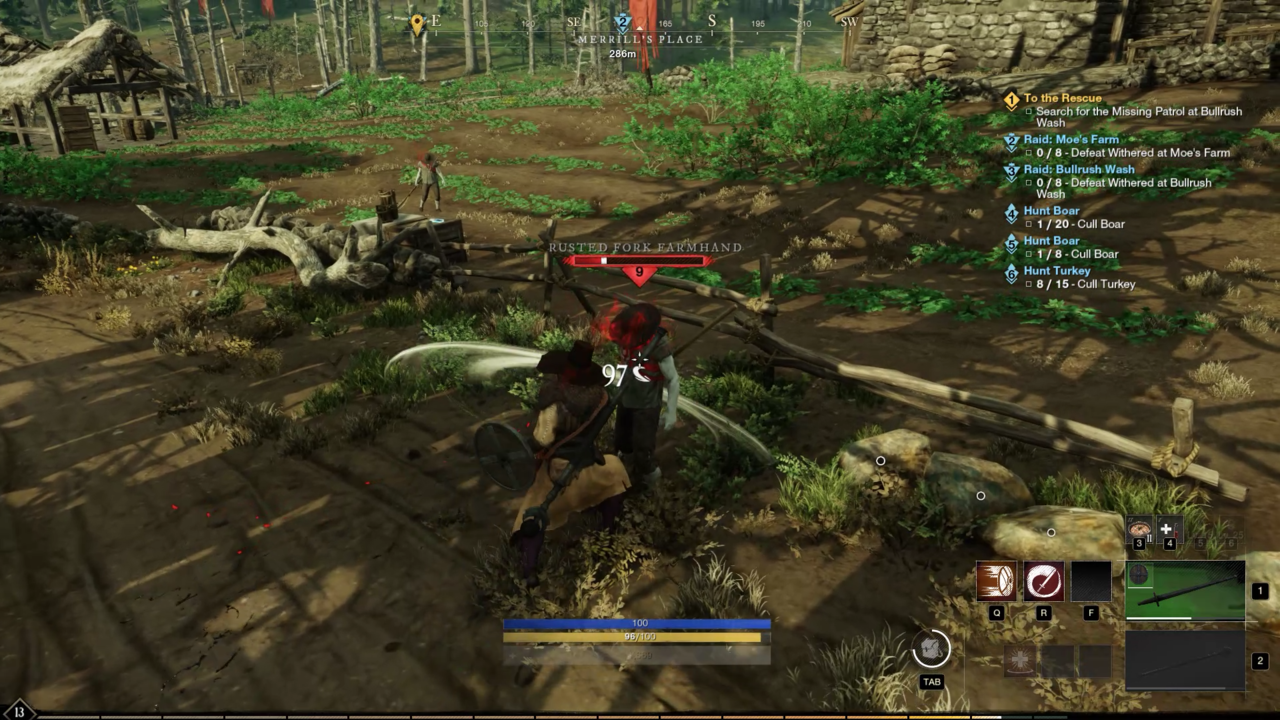
To call Wars both thrilling and chaotic would be an understatement. I've fought in a few in my time with the game so far, mostly on the defending side, and they have yet to get old. There is nothing like frantically firing arrows from the battlements of a fort as an encroaching army of players batters down the front gate, or participating in a flanking maneuver to take out the enemy's backline so your fellow comrades can advance. The scale and scope of the battles are impressive, and the fact that there are real(ish) stakes for the winning or losing team ratchets up the tension even higher.
Wars are by far one of New World's best elements, but it would all be for nothing if combat weren't enjoyable. Unlike many MMOs, New World's gameplay is action-focused. Players must dodge, block, use light and heavy attacks, aim for the head, and activate their various weapon abilities to emerge victorious, rather than simply right-clicking an enemy and tapping one of dozens of abilities on a hotbar. Its combat has more in common with a From Software-developed RPG than it does other MMOs. Even after having played for dozens of hours, it still feels satisfying to efficiently dispatch a group of enemies. It's entirely possible to take no damage at all from many of the game's PvE encounters, if you play your cards right and know when to block, when to dodge, and when an enemy's attack animations will leave them open to a counterattack. Each blow feels powerful, and enemies typically will fall after the use of a few abilities and basic attacks. That logic applies to your character as well, so making effective use of your defensive toolkit is critical to staying alive.
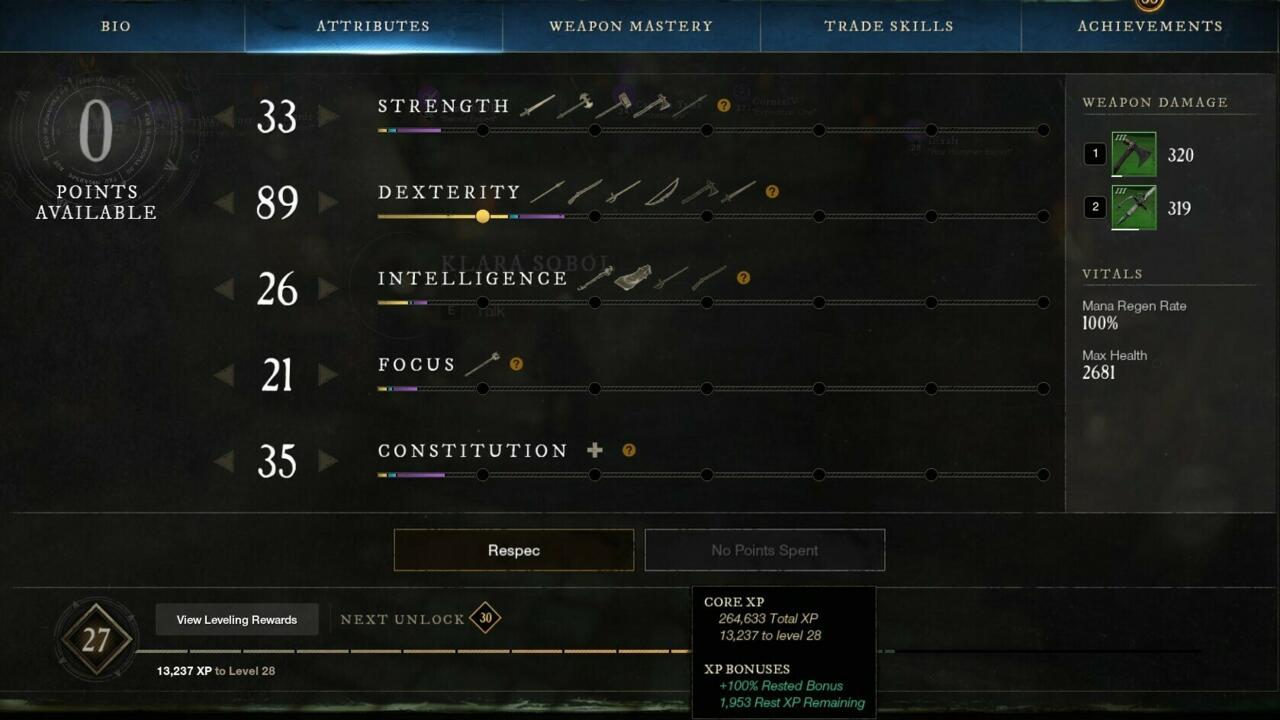
The more you use a particular type of weapon, the more its weapon mastery level goes up, allowing you to learn various active and passive abilities via a skill tree. You can choose from a variety of weapons like a two-handed hammer or a fire-spewing magic staff, and being able to equip two different weapons at a time allows you to mix and match weapons to find a suitable playstyle.
My go-to weapons quickly became the spear and bow, with my usual strategy involving attacking from range before switching to the spear once enemies got in close. Thanks to my weapon mastery choices, I could temporarily knock down enemies with my spear's sweep ability, allowing me to maneuver behind opponents and attack for bonus damage.
You'll be doing a whole lot of running. Running to the quest area. Running to turn in the quest. Running to talk to one person, only to have to run all the way back.
In another major departure from many contemporary MMOs, there are no classes in New World. Instead, players are largely defined by what gear they choose to use. Armor has weight, and hitting certain armor weight thresholds grant various bonuses. Having a light armor load, for example, allows players to perform a quick roll and provides a 20% damage buff that is ideal for ranged damage dealers, while heavy armor-using players can block longer at the cost of having reduced mobility, making heavy armor ideal for frontline fighters.
You're never locked in to a particular type of character in New World. Want to be a ranged assassin? Equip light armor, a musket, and a bow. Want to be an up-close-and-personal barbarian? Throw on heavy armor, a great axe, and a hatchet, and wade into the fray. I've tried numerous different builds in my time with the game so far, and I've found each to have its own appeal. I even served as a healer for a five-player group in one of the game's early dungeons, called Expeditions, five minutes after deciding to equip the game's sole healing weapon for the first time. While the damage of the game's various weapon types each scale in effectiveness based on certain base-character stats, you can respec both your weapon mastery skills and stat points for free at lower levels, allowing you to freely experiment. Even when those respecs eventually start to cost coin or other resources, the cost associated with redistributing stats and skills is fairly cheap, meaning you never have to feel like your choices are irreversible.

While PvP and combat are some of New World's strong suits, its actual leveling and questing experience feels archaic by comparison. Almost every quest in New World can be boiled down to stereotypical MMO quests that involve killing a certain number of enemies or looting a particular number of objects. You will do this ad nauseum. While the game's main story quest at least offers some unique characters and an occasional bit of intrigue, the vast majority of New World's side missions are about as barebones as they come. Not helping the sense of repetition is that you'll quickly run out of side missions in a given territory, essentially forcing you to resort to completing infinitely repeatable faction missions or crafting-focused town project board missions to gain enough experience points and levels to head to the next, higher-level territory. These faction missions are largely the same as the side missions (go here, kill that, loot those), but this time without even the thin veneer of a story or reason for doing so, with many of them taking you to the exact same areas with almost the exact same objectives as many side missions.
All the while, you'll be doing a whole lot of running. Running to the quest area. Running to turn in the quest. Running to talk to one person, only to have to run all the way back. Many modern MMOs have long solved this problem, either by allowing you to turn in quests from anywhere or having regional objectives that can be completed for experience and rewards as players come across them out in the open world. New World could desperately use a similar system, particularly for its PvE-based faction missions, which simply feel like the worst kind of busywork.
MMO worlds, by their very nature, are massive in size and scope. It makes sense then that they often allow players a means of traversing the environment more quickly, usually in the form of mounts. That's not the case in New World. While there is a flimsy (and somewhat comical) in-game lore explanation for why mounts in Aeternum are impossible, their absence is sorely felt.
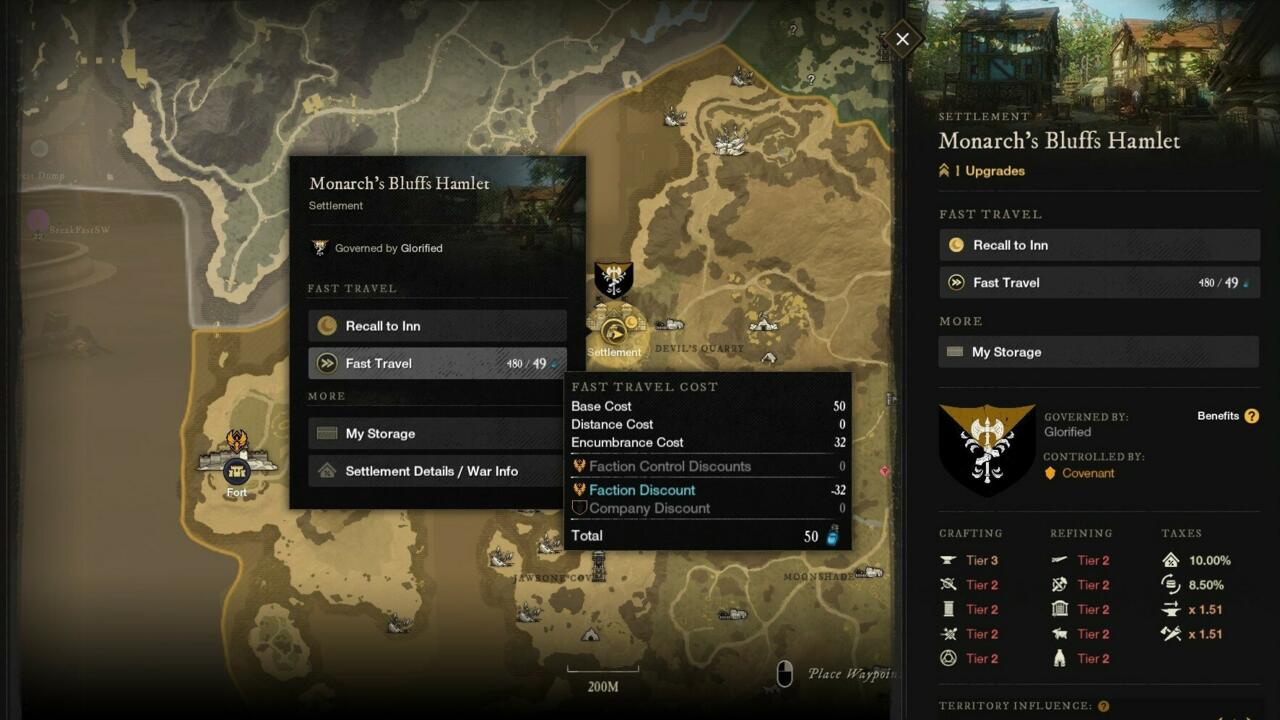
Instead of riding around on a personal steed, you'll mostly be running and (occasionally) fast traveling in order to navigate Aeternum. Fast travel in New World uses a resource called Azoth, and the amount of Azoth required varies depending on how far a distance you are traveling, the weight of the items in your inventory, and whether or not your faction controls the territory you are traveling to. You can fast travel from settlements you've already visited, as well as to fast travel shrines sprinkled throughout the world. Buying a home in a particular settlement will allow you to fast travel to it for free every few hours, and you can also register at one inn at a time to recall there once per hour at no cost.
Fast travel sounds like a suitable replacement for mounts in theory, but it's incredibly easy to find yourself out of Azoth, especially in the game's first two dozen hours. It's particularly an issue from levels 1-25, where your quests are likely to be scattered across multiple starting zones and the temptation to fast travel is high. Acquiring more Azoth isn't exactly difficult, as it's rewarded in small amounts for completing quests or can occasionally be earned when defeating enemies or gathering resources, but it is, at the very least, time consuming to replenish one's stores. The fact Azoth is capped at what feels like a painfully low amount only exacerbates the problem.
It is at least some consolation for having to spend so much time on foot that visually, Aeternum is absolutely stunning.
Compounding the game's traversal woes is the fact that dying often means having to spend a not-insignificant amount of time running back to your previous location. While dying doesn't carry too harsh a penalty in New World (your items lose some of their durability and eventually need to be repaired), it is time-consuming, as you'll often respawn at the nearest settlement and have to run back to finish whatever task you were previously working on. You can set down a camp as a respawn location, but you have to be within 500m of your camp upon death to respawn there, and camps can't be placed in named quest locations. More than a few times I found myself just out of range of my camp upon dying, and cursing under my breath as I began the long run back.

It is at least some consolation for having to spend so much time on foot that visually, Aeternum is absolutely stunning. Amazon has put a lot of work into the Lumberyard engine New World runs on, and it shows. Foliage blowing in the breeze, god rays peeking through the treetops, a layer of fog blanketing the hills, a rainstorm drenching the countryside--there's no denying New World is a beautiful sight to behold. Since you'll be spending significant time leveling in each, it's a shame that the game's starting zones of Monarch's Bluff, First Light, Windsward, and Everfall all feel like slight variations on each other (a side effect of having each and every player wash up on a ship-wreck covered beach), because once you get further inland, each zone begins to feel unique. While many of the named locations in each territory largely feel like carbon copies of each other--you will see a lot of very similar-looking ancient ruins and decrepit ghost towns, no matter what territory you are in--the actual environments do eventually start to stand out, with some of my personal favorites being the almost-always rainy Mourningdale or the swamplands of Weaver's Fen.
A large part of each territory's unique feel, and the feel of Aeternum as a whole, comes down to New World's orchestral score. Players may recognize composers Ramin Djawadi and Brandom Campbell from their previous work on scores for HBO's Game of Thrones and Westworld. New World's core theme, appropriately titled "Aeternum," perfectly encapsulates the ancient, mysterious, and epic environments players find themselves exploring, and the theme can be heard throughout New World, woven into various pieces of music. Even outside of the score, sound in general plays a major role in New World. From mining boulders to chopping trees, each swing of a pickaxe or hatchet sounds impactful and pitch-perfect as it echoes across the landscape. The twang of a bowstring or the crack of a musket feel equally powerful, and each distinct sound helps clue in nearby players on what's going on in the world around them. Hear the clang of steel on steel, or the shouts of players using magic? Sounds like there's a PvP skirmish happening just over the hill. The sharp-strike of a boulder being mined with a pickaxe? Perhaps someone has discovered a lucrative mining node, and you should keep your eyes out for more nearby.
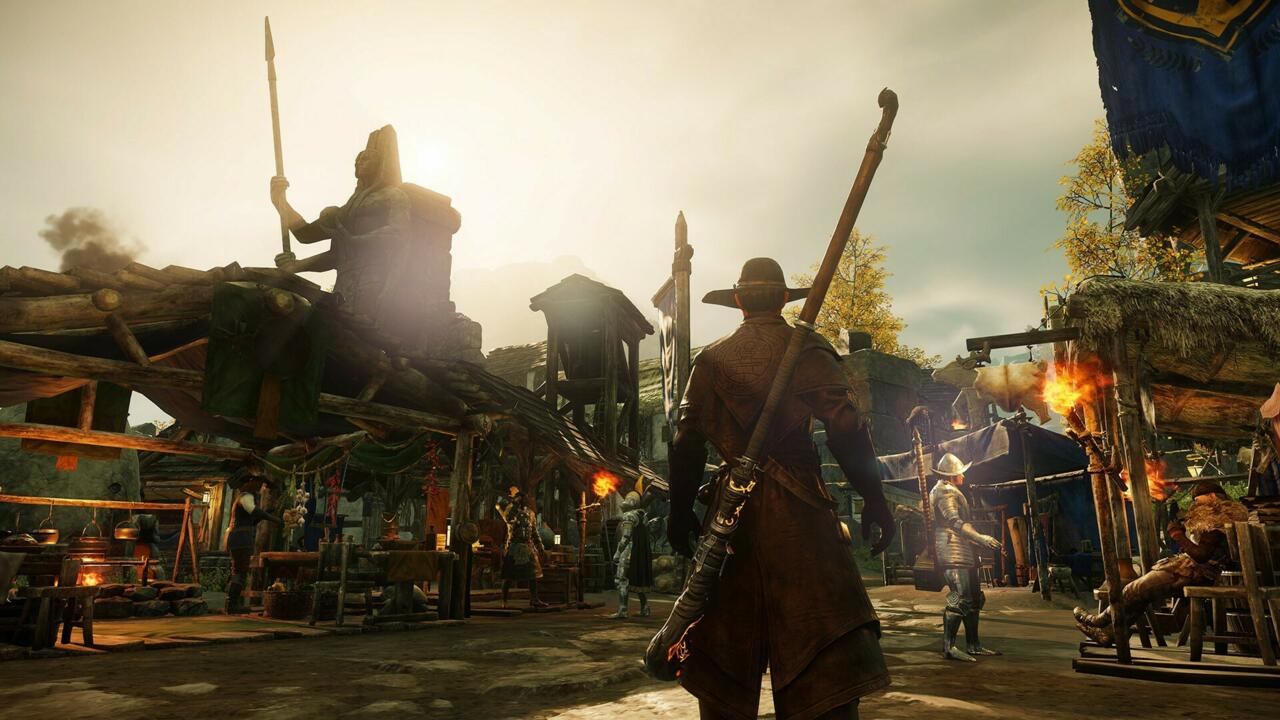
New World may be PvP focused, but there is content for those who would prefer to sit out the faction war and be left largely to their own devices. PvP is entirely optional, and while you are granted a 10% experience point boost for enabling PvP while out in the open world, it's rarely worth doing so if you're looking to make progress. Thankfully, players on different factions with PvP turned off can group up for player-versus-environment content, which comes in a few different forms. Expeditions serve as New World's version of dungeons, and are made all the more interesting by the fact that the game doesn't have traditional classes. Instead, certain weapon types have abilities that can serve as a "taunt" against enemies if a certain type of gemstone is socketed into the weapon, allowing players to fulfill a role not so different from a tank-class in other MMOs. There is a healing weapon in the form of the Life Staff too, allowing the wielder to buff and heal teammates and fulfill a support role in both PvE or PvP content.
Expeditions consist of light puzzle solving, rooms of enemies to defeat, and boss encounters. From the Expeditions I've done so far, bosses can be surprisingly involved, with multiple mechanics and phases players will have to successfully navigate in order to succeed. World events in the form of Corrupted portals, monoliths, and more will spawn periodically across various locations on the world map, and players can group up and go about cleansing them for experience points and other rewards. There are also PvE Arenas, which serve as high-level boss encounters that will put players to the test, but which I haven't actually gotten the chance to check out first-hand.
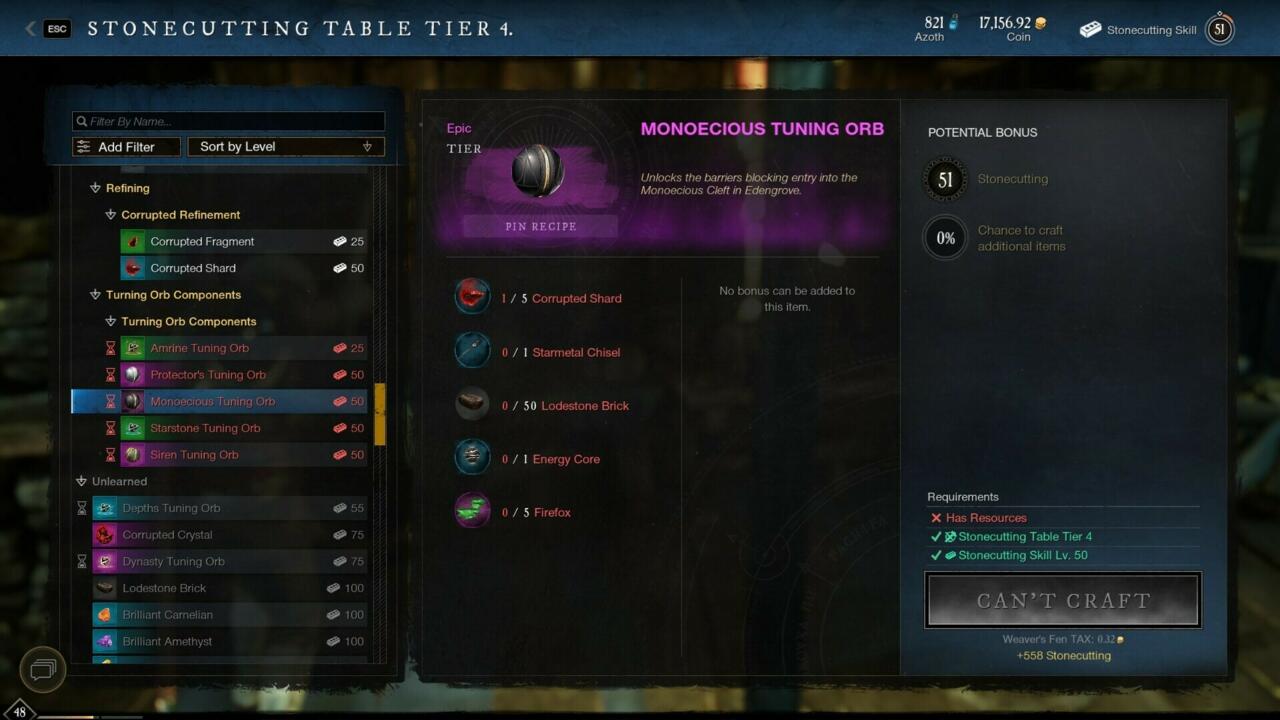
The catch is that Expeditions and Arenas are not infinitely repeatable. Instead, they require keys called Tuning Orbs, which are consumed upon entering the activity. While only one person per group needs to use an orb for all players to gain access, the orbs are primarily obtained through crafting and often require high-level resources to make. That means you aren't likely to be running Expeditions or Arenas regularly, leaving PvE-focused players looking for a break from the game's repetitive quests out in the cold aside from leveling up their various crafting skills.
Crafting is a huge part of New World. There are 17 different trade skills players can level up, but players don't have to select just a few of these skills to focus on and instead can do all of them. Each skill is interconnected, with many items from one skill requiring items gathered or created from another skill, meaning you'll be using and leveling up a little bit of everything as you progress through the game.
While server issues and various bugs have already dramatically improved from launch day, it still remains to be seen how New World will stand the test of time.
Trade skills are doubly important considering the fact that, outside of the faction vendors, there are no NPCs from which to purchase or sell items. New World's economy is entirely player-driven, from the goods for sale to the taxes in each settlement. Trade posts in each settlement allow players to buy and sell goods from one another, and players can also trade money and items directly.
Although New World is lacking in terms of a strong central narrative or even real characters, it still feels alive thanks to its lush environments, beautiful soundscapes, and the players occupying and running each server. Players are truly at the center of New World, and the emergent stories and gameplay that evolve from interacting with complete strangers or fighting in a three-way faction war will ultimately be what shapes its future. Even in the game's first few weeks, I've made numerous in-game friends and participated in events that have gone on to become part of my server's unique history. It's a one-of-kind experience in gaming that's only possible in a MMO, and it's all thanks to New World letting each server tell its own story.
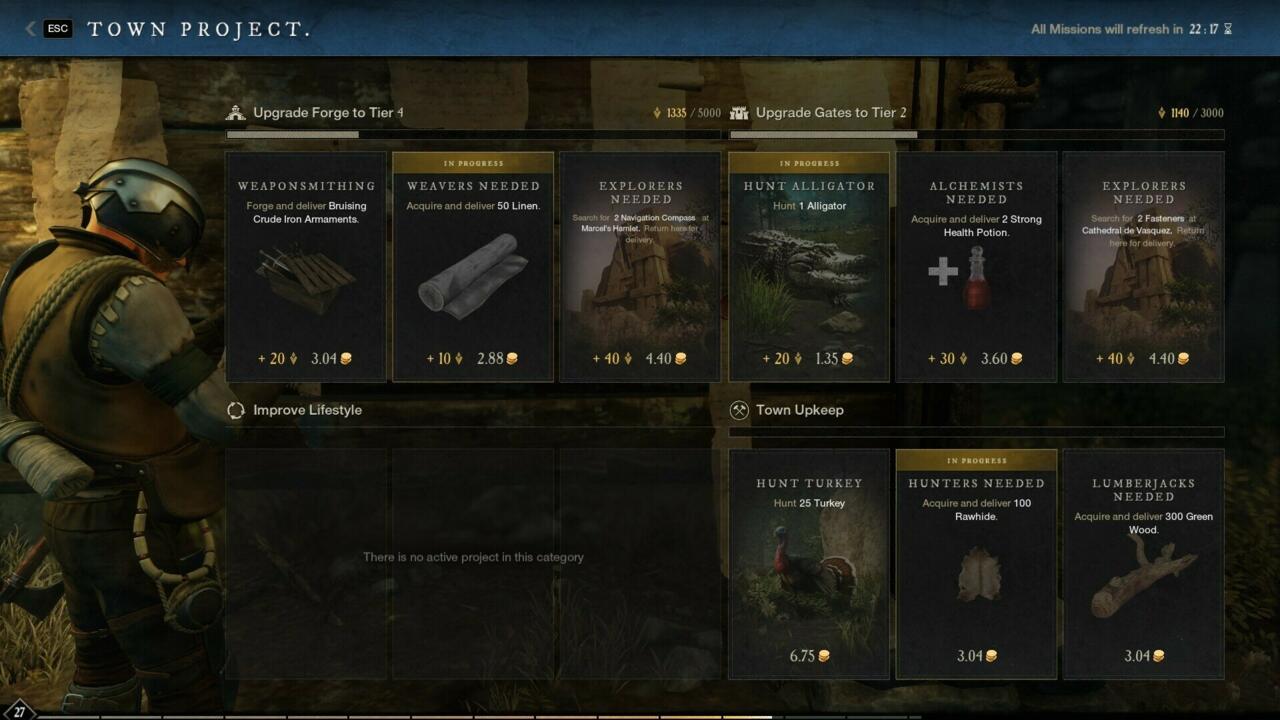
But players holding the keys to the kingdom can be a double-edged sword, too. As unfortunately seems to be par for the course with many MMOs, company drama has already consumed the Covenant on my server, with a major company leader stealing a large sum of coin donated by other company members and then defecting to another faction. While faction changes can only be done every 120 days, it still seems like there should be more systems in place to prevent such blatant abuses of power. While players of any company (and technically even other factions) can sign up to join another company's War, there is already no shortage of gatekeeping, making it so unless you are a prominent member of an established company, your chances of participating in one of the game's most exciting events are slim to none. It also remains to be seen what the experience for players on opposing factions will be if a server should come to be dominated by one faction in particular. I can easily see a scenario where one faction owns every territory on a server, and jacks up the tax rates as high as they will go in order to extract as much money as possible from players of the other factions.
In a game where such high-stakes PvP scenarios are attached to territory control and economic prosperity, having some of those systems not work properly can be a splash of cold water on an otherwise captivating experience. In my first War experience, just as my faction was about to lose, a server hiccup booted everyone in the battle back to the main menu, allowing us to keep our territory. I've also been on the other end of that spectrum, watching as my faction worked for hours to build up influence in opposing territory, only to have a bug prevent the Covenant from declaring War. And there are little issues too, ones that are hardly game-breaking but are frustrating nonetheless: I've been unable to loot items or interact with the environment on multiple occasions, requiring me to relog, and it seems as if my in-game achievements and titles are frequently broken. The ability to auto-run, something players will be making liberal use of in New World, also has a tendency to stop functioning at random times. Much bigger bugs have also plagued the game in the weeks since launch, with a recent coin duplication exploit forcing Amazon to shut down the game's entire economy for a day. Such game-breaking exploits have been addressed quickly, but if New World wants to stand the test of time, Amazon will need to stay one step ahead when it comes to ensuring a fair playing field.

Aside from technical issues, there are also a handful of smaller design choices that put a serious damper on the overall game experience. From the very get-go, New World is not particularly accommodating when it comes to playing with friends. Upon starting the game, players randomly spawn in one of Aeternum's four starting zones. It is very likely that you and your friend will not spawn in the same one. If you want to meet up, it means one of you will have to spend upwards of 30 minutes running across multiple territories. Alternatively, you can both play separately for multiple hours until it's convenient to meet up in a neighboring settlement where neither of you have yet accepted any side missions, though that's hardly a satisfying solution. The issue is obviously one Amazon has noticed, as a recent update actually reduced the number of in-game starting areas to three. However, even with one fewer starter area, the problem persists. Going hand-in-hand with this issue is the inability to share quests in New World, which can make it needlessly difficult to do PvE content with friends. The fact that each settlement's trading post is independent of each other is another pain point and means it's often a hassle to actually find the items you're looking for without having to travel to a different settlement, something that further adds to the frustration of the game's Azoth-fueled fast travel system.
Some of New World's more frustrating issues are largely felt while leveling. In theory, the experience would improve once players hit max level. Unfortunately, New World's endgame is lacking. Hitting level 60 after 100+ hours should feel like an accomplishment, but the reward is largely doing more of the same. New World's endgame primarily consists of farming specific chests, Corrupted areas, and zones of elite enemies for progressively better loot. Oftentimes this means grouping with a large number of players to run around and kill everything in sight, which can be a fun shared experience, but does not exactly deliver engaging gameplay. Alternatively, you can spend dozens of hours maxing out various tradeskills to create better items, but that won't likely be the route most players choose when it comes to endgame progression. There are a handful of max level Expeditions and Arenas for players to participate in that offer compelling rewards, but as previously mentioned, they are not something most players will be doing frequently thanks to the time and cost associated with crafting the required keys needed to gain access.
The result is an endgame experience that just kind of, well, ends. Aside from the ongoing faction struggle, there is little to motivate players to grind their gear score to the max of 600, as there is so little content to participate in that it feels largely pointless. That being said, there are a few additional activities that do unlock at higher levels that are worth mentioning. Invasions are essentially PvE versions of the game's PvP Wars that players can sign-up for, but the wave-based Horde mode is so challenging currently that it hardly feels worth the time and effort required given the lackluster rewards. Outpost Rush, a 20v20 PvP mode that takes inspiration from games like League of Legends and the Alterac Valley battleground from World of Warcraft, fares much better. Unfortunately, the mode is not cross-server, meaning the pool of available players is only max level characters on your specific server. This means if you aren't playing on a populated server and at a peak playtime, you could be waiting hours to participate in one of New World's only true endgame activities.
All of the above, of course, is subject to change. Amazon is looking to roll out changes to the game's trading posts that will link them across territories, alongside the addition of new enemy types, more quest variety, additional weapons, and much more. It's clear Amazon is in this for the long haul and has focused on building a solid foundation at launch upon which to add additional content over time.
As it stands a little over a month after launch, New World offers a solid PvP-focused, player-driven MMORPG experience that has long been missing from the genre, albeit one seriously held back by outdated quest design and a lack of interesting endgame content. Whether that changes in the months ahead remains to be seen, but for now, New World will likely only appeal to those who crave PvP and wish to paint the map of Aeternum the color of their chosen faction, repetitive questing and lack of content be damned.











